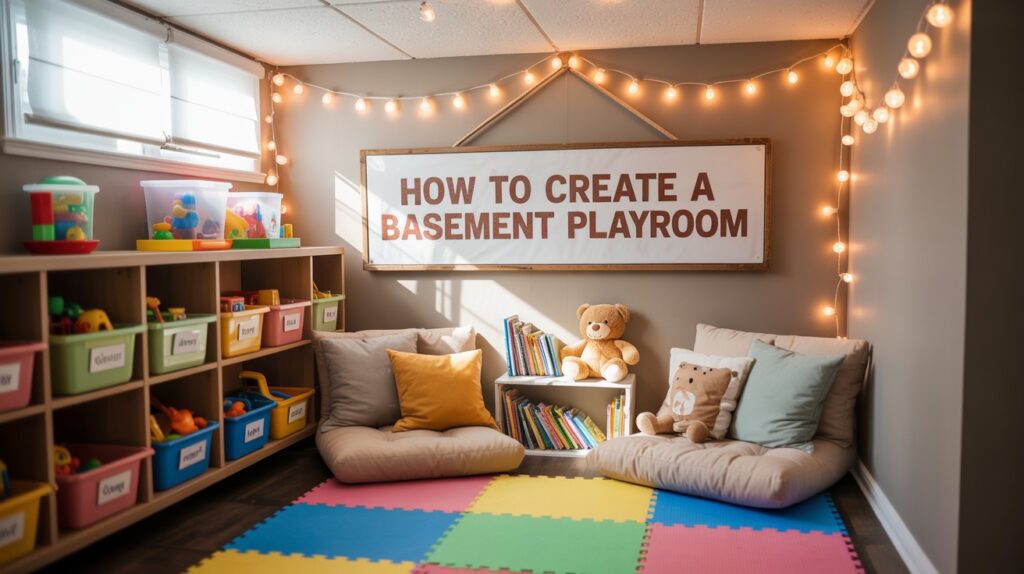I know what you’re thinking. A basement playroom sounds expensive and complicated. But here’s the truth, it doesn’t have to be.
Your basement holds amazing potential. It’s waiting to become the perfect play space for your kids. Think about it – extra room for toys, games, and creative chaos. A safe spot where children can be loud and messy without worry.
The best part? You can make it happen without breaking the bank.
I’ve helped countless families enhance their basements into magical play spaces. The secret isn’t spending more money. It’s spending smarter. With the right approach, you’ll create a space your kids will love for years to come.
Ready to turn that empty basement into your family’s favorite room? Let’s start building memories on a budget.
How to Create a Basement Playroom on a Budget
A practical guide for parents who want to boost their unused basement space into a fun, safe playroom for children without spending a fortune. Learn money-saving tips, DIY solutions, and creative ideas to build the perfect play space on any budget.
Check the Space First
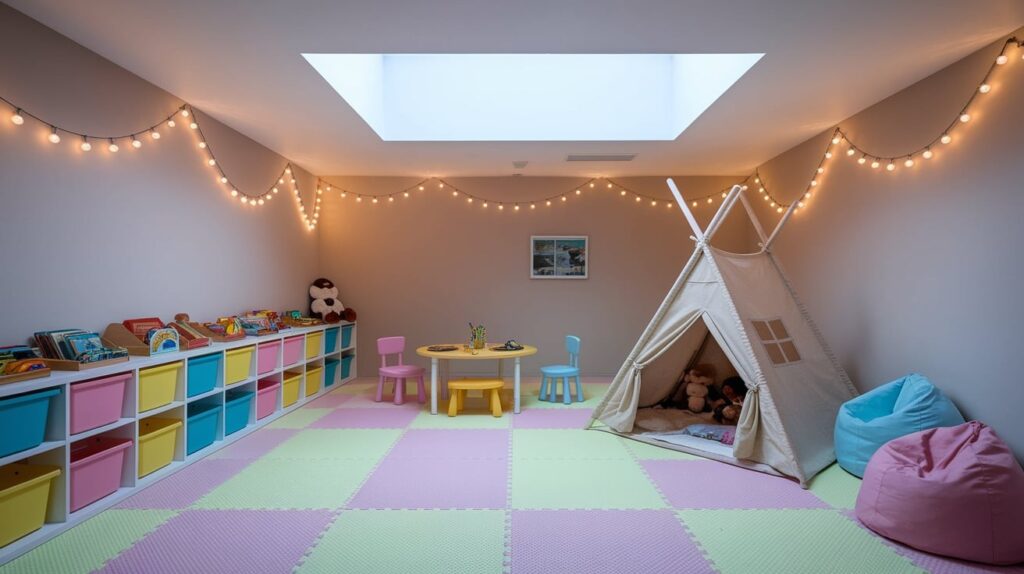
Before you buy anything, inspect your basement carefully. Water damage can ruin your plans and waste money.
Look for these warning signs:
- Damp spots on walls or floors
- Musty smells that won’t go away
- White powder on concrete surfaces
- Puddles after heavy rain
Don’t skip this step. Fix moisture problems first.
Next, examine the lighting situation. Basements are naturally dark. You’ll need bright, even lighting for safe play. Count your current light fixtures. Plan where you might add more.
Check the air flow too. Stuffy air makes playing uncomfortable. Open windows if you have them. Consider a small fan for circulation.
Safety comes first with children involved. Test all electrical outlets and install safety covers. Make sure stair railings are secure. Look for sharp corners or protruding nails that need attention.
Set a Simple Budget Plan
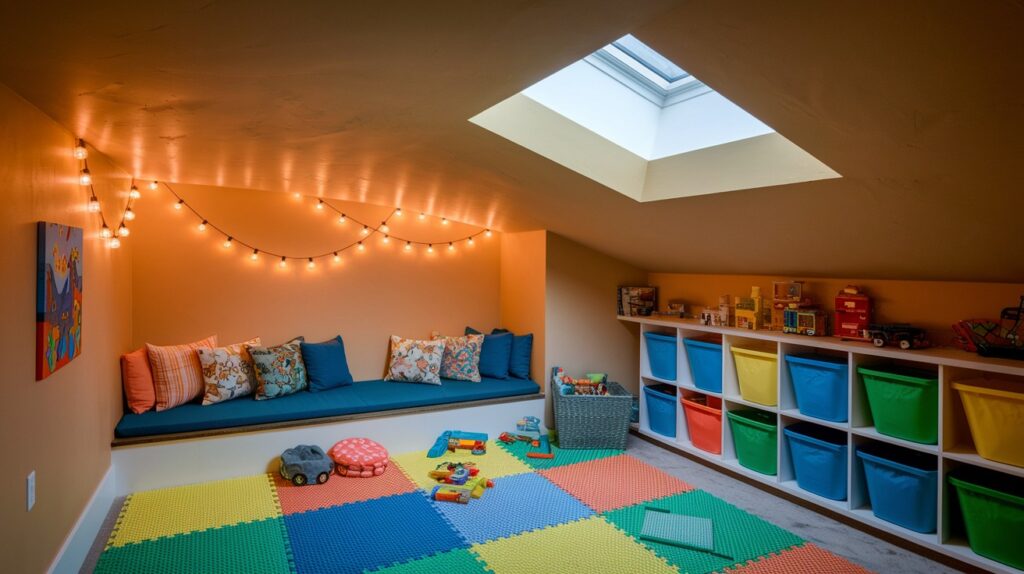
Smart budgeting starts with knowing what you actually need versus what would be nice to have.
Your must-have list should include:
- Safe flooring
- Basic storage
- Good lighting
- Essential safety items
Nice-to-have items can wait:
- Fancy decorations
- Expensive furniture
- High-tech gadgets
- Professional paint jobs
I recommend dividing your budget into categories. This keeps spending focused and prevents overspend in one area.
Try this breakdown:
- 40% for flooring and safety
- 30% for storage solutions
- 20% for furniture and seating
- 10% for decorations and extras
Always add a 15-20% buffer money. Unexpected costs pop up in every project. This cushion prevents stress and keeps your project moving forward.
Budget Flooring Options
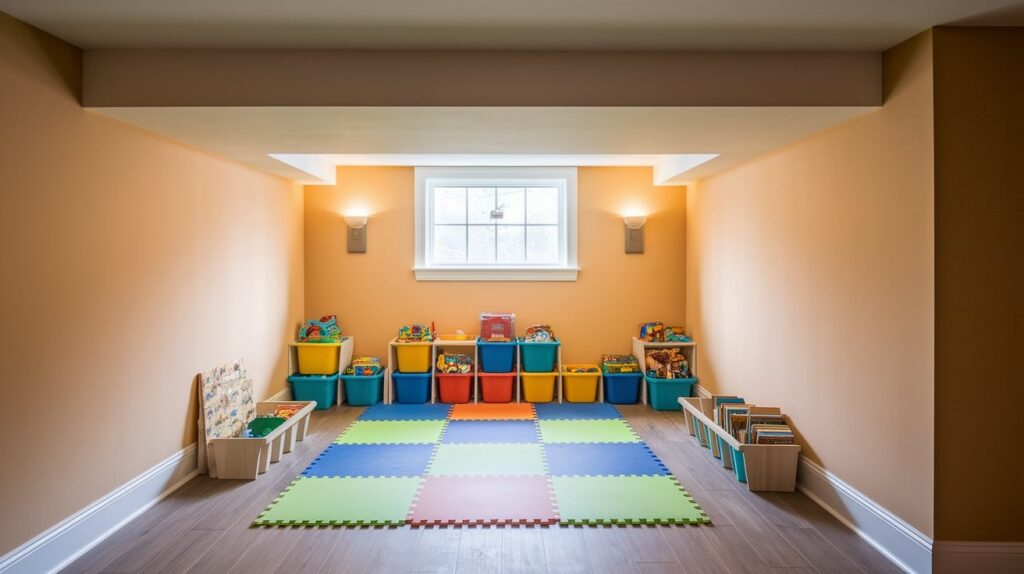
Basement floors need special attention. Kids need something comfortable for playing and sitting.
Foam Interlocking Tiles: Foam interlocking tiles work great for playrooms. They’re soft, colorful, and easy to clean. You can find them at discount stores for much less than specialty retailers. They also provide cushioning for falls.
Area Rugs: Large area rugs offer another affordable solution. Look for machine-washable options since spills happen frequently. Thrift stores often have barely used rugs at great prices.
Painted Concrete: Don’t overlook painted concrete. A few coats of floor paint can brighten the space dramatically. Choose light colors to reflect more light. Add some colorful tape designs for visual interest.
Construction Surplus Materials: Check construction surplus stores for leftover flooring materials. Contractors often sell extra tiles, vinyl, or carpet at deep discounts.
Affordable Storage Ideas
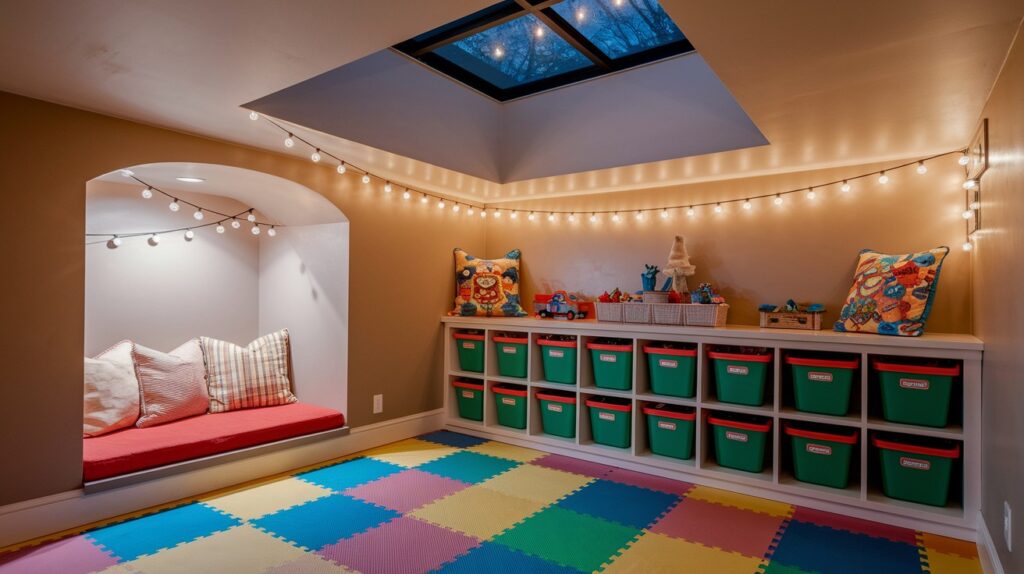
Kids create messes quickly. Smart storage makes cleanup fast and teaches organization skills.
Free Wooden Crates: Wooden crates make excellent toy storage. You can often find them for free behind grocery stores or farmers’ markets. Sand them smooth and add a coat of paint for a custom look.
Repurpose What You Have: Repurpose plastic bins and baskets you already own. Clear containers let kids see what’s inside. This reduces dumping and searching through multiple bins.
Transform Old Bookshelves: Convert old bookshelves into toy storage cubbies. Remove some shelves to create larger spaces for bigger toys. Add fabric bins or baskets for smaller items.
Label Everything: Label everything with pictures and words. Young children respond better to visual cues than text alone. This system makes cleanup faster and more independent.
Use Under-Stair Space: Consider under-stair storage if your layout allows it. This dead space works perfectly for seasonal toys or backup supplies.
Smart Ideas to Maximize Fun & Savings
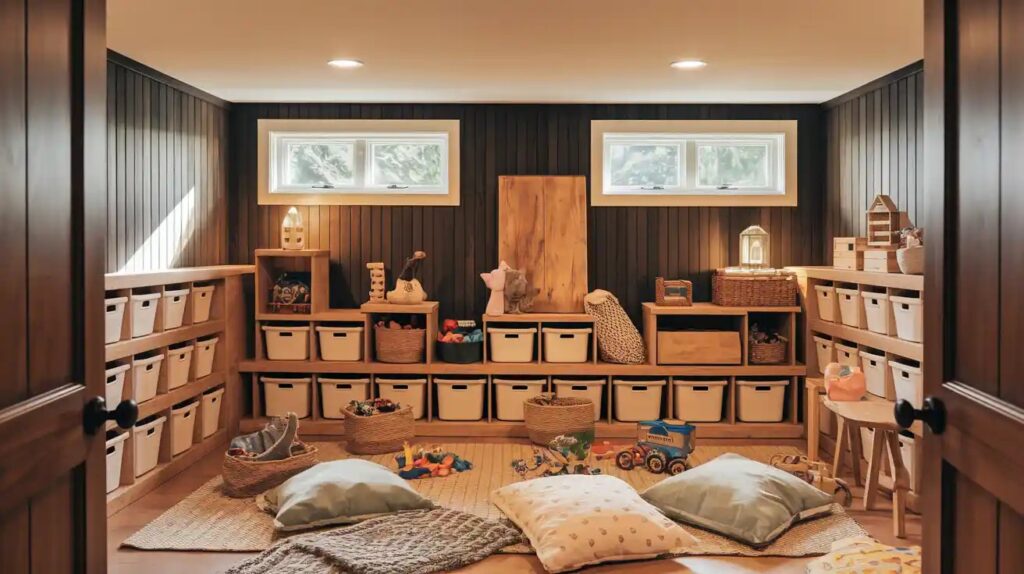
- Creating an engaging playroom requires more creativity than cash. These ideas stretch your budget while boosting entertainment value.
- Rotate toys monthly to maintain novelty. Store half the toys in bins upstairs. Switch them out regularly. Kids will react like they’re getting new toys every month.
- Build a cozy reading nook using pillows and a simple canopy. Hang a sheet or fabric from the ceiling for instant magic. Add battery-powered lights inside for reading time.
- Set up a dress-up station with a mirror and a simple clothing rack. Ask family members to donate old clothes, shoes, and accessories. Kids love pretending to be different characters.
- Large cardboard boxes become anything in a child’s imagination. Castles, spaceships, kitchens, or forts – the possibilities are endless. Appliance stores often give away large boxes for free.
- Use colored tape to create activity zones on the floor. Make hopscotch grids, roads for toy cars, or boundaries for different play areas. This costs almost nothing but adds structure to the space.
- Paint one wall with chalkboard paint for drawing and games. Kids can create and erase artwork endlessly. This interactive wall becomes a favorite feature in most playrooms.
Budget Decor & Furniture Tips
- String lights instantly warm up any basement space and cost very little
- Wall decals offer design flexibility and change easily as kids’ interests grow
- Bean bags provide comfortable seating that kids can move around freely
- Check thrift stores for children’s furniture, as families often sell quality pieces cheaply
- Folding tables work well for crafts and store flat against walls when not needed
- Use old sheets or fabric as simple wall hangings to add color and softness
- Repaint old furniture with bright colors to give it new life in the playroom
- Add throw pillows and blankets to make hard surfaces more comfortable for sitting
- Create simple artwork frames using cardboard and colorful tape instead of buying expensive ones
Final Touches That Make It Special
Display their artwork prominently using clips on string or in inexpensive frames. Rotate the display regularly so every creation gets featured. This makes children feel valued and proud.
Create a special name sign for the playroom entrance. Use wooden letters from craft stores or make your own from cardboard. Let kids help decorate it with paint or markers.
Display their artwork using clips on string or cheap frames. Create a special name sign for the entrance. Add fairy lights in mason jars for a magical ambiance.
Consider a mild scent diffuser with kid-friendly scents like vanilla. Include soft throw pillows or blankets to make the space feel warm and inviting.
Conclusion
Building your dream playroom doesn’t require a huge budget. It needs creativity, patience, and smart shopping.
Start with one section at a time. Maybe flooring first, then storage, then decorations. This approach spreads costs over time and prevents overwhelm. Your kids will love watching their special space grow.
Remember that handmade and repurposed items often become the most treasured elements. Children value the effort and love you put into their space more than expensive store-bought items.
The best playrooms evolve with your family’s needs. Stay flexible and keep improving gradually. Your basement will become the heart of your home – a place where imagination grows and memories are made.
What will you tackle first in your basement transformation? I’d love to hear about your creative solutions and money-saving wins!
Frequently Asked Questions
How much should I expect to spend on a basic basement playroom?
Most families spend between $300-800 for a complete basement playroom makeover. This includes flooring, storage, basic furniture, and decorations. You can start with $200 for essentials and add items over time. The key is prioritizing safety items first, then building up the fun elements gradually.
What’s the biggest mistake people make when creating basement playrooms?
Skipping moisture testing is the costliest error I see. Families spend hundreds on flooring and furniture, only to find mold or water damage later. Always address moisture issues before adding anything else. It’s also common to over-buy storage initially – start with basic bins and add more as needed.
How do I handle low ceilings in my basement playroom?
Low ceilings work well for young children since everything feels more proportional to their size. Focus on horizontal storage rather than tall shelves. Use light colors on walls and ceilings to create the illusion of more space. Avoid hanging decorations that dangle down. Floor cushions work better than tall furniture.
Is it safe to let young children play unsupervised in a basement?
Basement playrooms work best for children over 4 years old who can safely use stairs independently. Always install safety gates at the top of stairs for younger kids. Ensure proper lighting throughout the space and remove any hazards like exposed pipes or sharp corners. Baby monitors help you keep tabs on play activities from upstairs.
How do I keep the basement playroom from getting too messy?
Smart storage systems prevent chaos. Use the “one bin out, one bin away” rule. Label everything with pictures so kids can clean up independently. Rotate toys monthly to reduce clutter. Set up specific zones for different activities – this naturally contains messes. Schedule 10-minute cleanup sessions before leaving the playroom each day.

